ここから本文です。
Kaii Higashiyama Profile
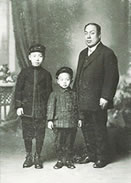
Kaii Higashiyama (center), together with his father, Kosuke, and his elder brother, Kunizo. 1913
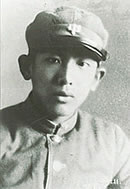
First-year student at higher school (under the old system of education).1921
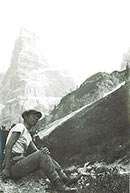
Near the top of Monc Blanc, Switzerland. A photo of his travel in Europe during his study in Germany. 1934
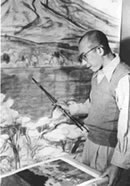
Drafting one of his masterpieces, Twilight.
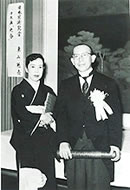
The Japan Academy Awards ceremony. 1956.

Dialogue with the chair in the Tuileries Garden, Paris. 1975.
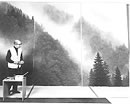
Drawing the Toshodaiji Miei-do Murals, Mountain Clouds.
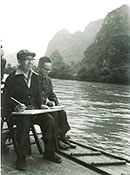
Sketching at Guilin. 1976.
Brief Biography
| 1908 | Born on July 8 in Yokohama, the second son of Kosuke Higashiyama (a ship chandler) and his wife, Kuni. His given name was Shinkichi. At the age of three, he moved to Kobe. As a child he showed great interest in art and often painted in his free time. |
|---|---|
| 1921 | Entered Hyogo Prefectural Daini Kobe Higher School (now Hyogo High School). He decided to become a painter after a suggestion from his junior high school teacher. |
| 1926 | Entered the Nihon-ga (Japanese-style painting) Department of the Tokyo Fine Arts School (now Tokyo University of the Arts). |
| 1931 | Graduating from the Tokyo Fine Arts School, he entered into its graduate school, where he began training under Somei Yuki. He adopted the name "Kaii", instead of "Shinkichi" when signing his works. |
| 1933 | Finished at graduate school of the Tokyo Fine Arts School. To study in Germany, he boarded a cargo ship bound for Europe in August, arriving in Berlin in October. He studied in the foreign students department, frequenting the local art galleries. |
| 1935 | Although he had planned to study in Europe the following year, he was called back to Japan after completing his second semester at Berlin University as his father was ill. |
| 1940 | On November 21, he married Sumi Kawasaki, the eldest daughter of Shoko Kawasaki, a painter. They lived in Saginomiya, Tokyo. |
| 1945 | He served from July until the end of the war on August 15. In December, he moved to Ichikawa, Chiba. He began painting again. |
| 1947 | In October, he exhibited “Dim Sunlight” in the 3rd Nitten (National Art Academy) Exhibition. The painting was admired so much and purchased by the government. He decided to concentrate his efforts on landscape painting. |
| 1950 | Appointed a member of the Nitten Exhibition jury for the first time, he entered "Road" in the 6th Nitten Exhibition, a work that won him the recognition of both the art world and public. |
| 1956 | Received the Japan Art Academy Award for "Twilight” painted the previous year. It was later purchased by the government. In October, he exhibited "Pine Garden" in the 12th Nitten Exhibition. |
| 1959 | In November, entered "Sea at Dusk" into the 2nd Shin-Nitten exhibition. This is a painting of Hituishi island, that is in Sakaide, Kagawa, and his grandfather had been born and raised on. |
| 1960 | He painted murals "Sun, Moon, and the Four Seasons" in celebration of the construction of the Togu( crown prince) Palace. |
|
1961 |
He painted "Draped in Fresh Green" for the new Fukiage Palace. The work was unveiled at an completion ceremony in November. In May, his first retrospective exhibition was held in Tokyo. |
| 1965 | In January, he was appointed a member of the Japan Art Academy, and accepted the post of Shin-Nitten Exhibition director. At this time, he decided to use waves and rocks as motifs for the murals in the New Imperial Palace to symbolize Japan. |
| 1968 | In April, he completed the murals in the New Imperial Palace. He was appointed a member of the Specialist Committee of the Council for the Protection of Cultural Treasures, and in November he held an exhibition of 17 sketches and studies under the title "The Four Seasons of Kyoto". |
| 1969 |
In January, he was awarded the Mainichi Art award for "Tide at Daybreak" and the production of the exhibition. From April to September, he made a sketching tour of Germany and Austria with his wife. In November, he awarded the Order of Culture. |
| 1973 | From January, he traveled throughout Japan on a sketching tour for preparation of painting the murals at Toshodaiji temple. As a result of travels, he chose mountains and the sea as motifs. In August, he exhibited for the first time in Kagawa. The exhibition of 150 works was divided into four themed groups: "Northern European Lanscapes", "The Four Seasons of Kyoto", "Journeys through Austria and Germany" and "Scenery with white horses". |
| 1974 | He became chairman of the board of directors at Kaiso-Nitten. |
| 1975 | He painted "Spring Daybreak" as a gift from the Emperor and Empress of Japan to the Queen Elizabeth II on her state visit to Japan. In May, he completed the first group of murals for Toshodaiji temple, titled "Mountain Clouds-The Sound of Waves". He dedicated them to the temple in June. |
| 1977 | In April, "The Toshodaiji Temple Exhibition" was held at the Petit Palais in Paris, which included "Mountain Clouds" and "The Sound of Waves". |
| 1980 | In February, he completed the second group of three murals for Toshodaiji temple, titled "Dawn Clouds at Huang-shan", "May Breeze in Yangzhou", and "Moonlit Night at Gujlin. They were exhibited in Tokyo, Osaka, Nagoya, in June. After then, he officially dedicated them to the temple. |
| 1981 | In August, he held a "Kaii Higashiyama Exhibition" at the National Museum of Modern Art, Tokyo. In November, he officially dedicated his work "Benign Light" to Toshodaiji temple. |
| 1984 | In April, he became adviser to the Nitten Exhibition. In June, he was selected to join "Der Orden Pour le Merite fur Wissenschaften und Kunste", the committee at the Federal Republic of Germany. The following year, he received the award at University of Bonn. |
| 1990 |
In January, Kaii received a commission to paint a screen. The work is showing folksongs from the Yuki region (east of Japan), for the celebrations for the enthronement of the Emperor. It was finished in September and shown at the ceremony in November. In April, Nagano Prefectural Shinano Art Museum / Higashiyama Kaii Gallery was opened in Nagano. |
| 1994 | In November, the Higashiyama Kaii art gallery was opened in Ichikawa, Chiba. |
| 1995 | In August, the Kokoro-no-Tabiji, Spiritual Journey art gallery was opened in Yamaguchi village, Nagano. |
| 1998 | In November, "Moonlight" was entered into the 30th Nitten exhibition. It was his last work entried Nitten exhibition. |
| 1999 | On May 6, Kaii Higashiyama passed away, due to old age. He was 90 years old. He awarded the Grand Cordon of the Precious Crown, 3rd class. |
| 2005 | In April, the Higashiyama Kaii Setouchi Art Museum was opened by Kagawa Prefecture. |
『東山魁夷 自然のなかの喜び』(講談社刊)
“Higashiyama Kaii ”Kodansha Culture Books 100 , 1995.
このページに関するお問い合わせ